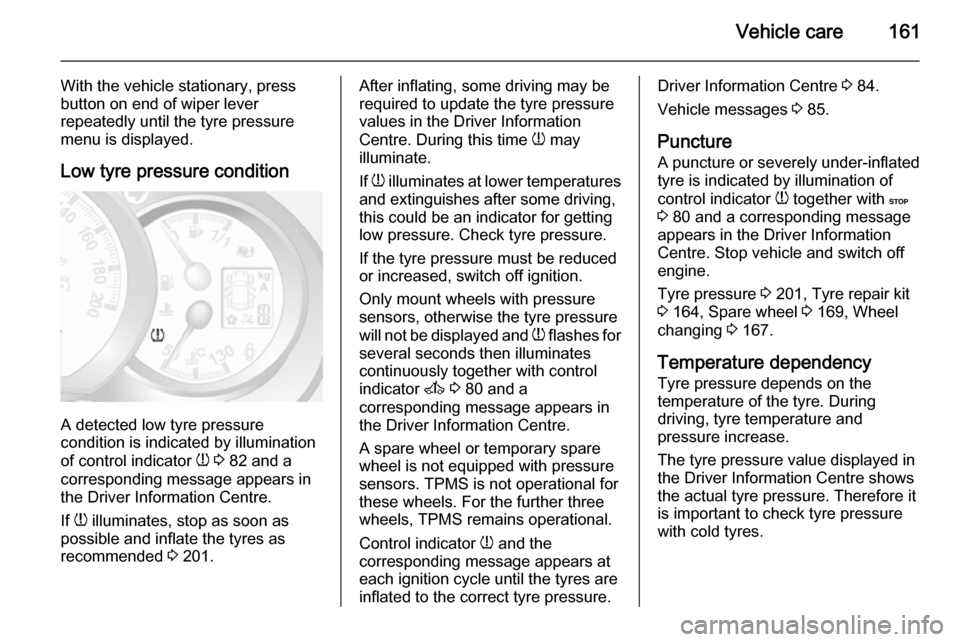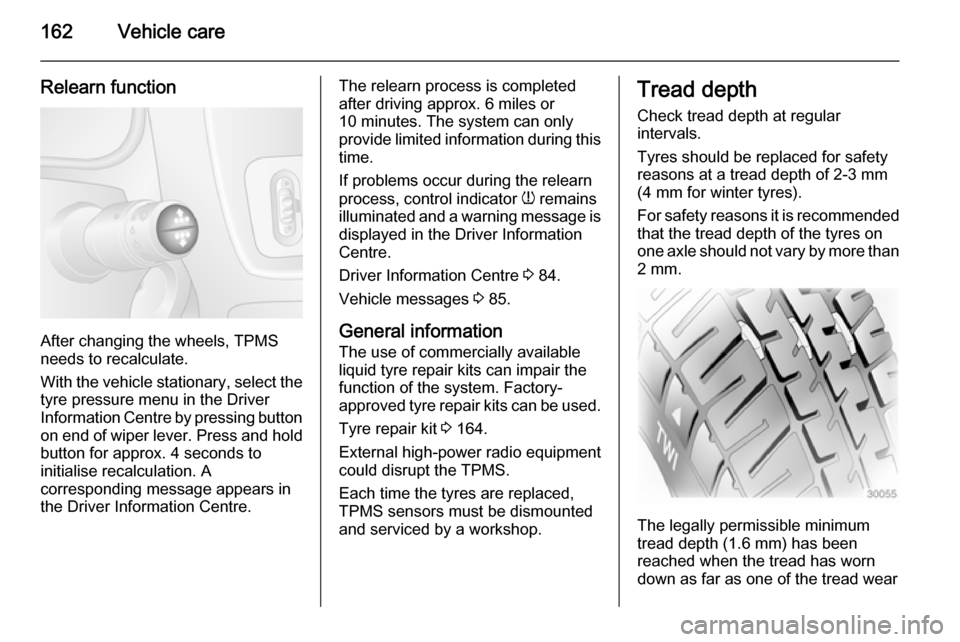2015.5 VAUXHALL MOVANO_B sensor
[x] Cancel search: sensorPage 132 of 215

130Driving and operating
Cruise control speed limiter 3 126.
Parking assist The parking assist makes reverse
parking easier by measuring the
distance between the rear of the
vehicle and obstacles. It is the driver,
however, who bears full responsibility for the parking manoeuvre.
The system consists of four ultrasonicparking sensors in the rear bumper.
Notice
Attached parts in the detection area
cause system malfunction.
Activation
When reverse gear is engaged, thesystem switches itself on
automatically. Readiness for
operation is indicated by a brief
acoustic alarm.
An obstacle is indicated by buzzers.
The interval between the buzzers
becomes shorter as the vehicle gets
closer to the obstacle. When the
distance is less than 30 cm, the buzzer is continuous.9 Warning
Under certain circumstances,
various reflective surfaces on
objects or clothing as well as
external noise sources may cause the system to fail to detect
obstacles.
Special attention must be paid to
low obstacles which can damage
the lower part of the bumper.
Caution
Performance of the sensor can be reduced when sensors are
covered, e.g. by ice or snow.
Performance of the parking assist
system can be reduced due to
heavy loading.
Special conditions apply if there
are taller vehicles involved (e.g.
off-road vehicles, mini vans,
vans). Object identification in the
upper part of these vehicles
cannot be guaranteed.
Objects with a very small reflection
cross section, like objects of
narrow size or soft materials, may
not be detected by the system.
Parking assist will not detect
objects out of the detection range.
Page 162 of 215

160Vehicle care
Tyre pressures differ depending onvarious options. For the correct tyre
pressure value, follow the procedure
below:
1. Identify the engine identifier code.
Engine data 3 185.
2. Identify the respective tyre.
The tyre pressure tables show all possible tyre combinations 3 201.
For the tyres approved for your
vehicle, refer to the EEC Certificate of
Conformity provided with your vehicle or other national registration
documents.
The driver is responsible for correct
adjustment of tyre pressure.9 Warning
If the pressure is too low, this can
result in considerable tyre warm-
up and internal damage, leading to tread separation and even to tyre
blow-out at high speeds.
Rear-wheel drive, with twin rear
wheels When inflating the outer tyre, the
inflation tube should be passed
between the two wheels.
Tyre pressure monitoring
system
The Tyre Pressure Monitoring
System (TPMS) uses radio and
sensor technology to check tyre
pressure levels.Caution
Tyre pressure monitoring system
warns only about low tyre pressure
condition and does not replace
regular tyre maintenance by the
driver.
All wheels must be equipped with pressure sensors and the tyres must
have the prescribed pressure.
Notice
In countries where the tyre pressure
monitoring system is legally
required, the use of wheels without
pressure sensors will invalidate the
vehicle type approval.
The TPMS sensors monitor the air
pressure in the tyres and transmit tyre pressure readings to a receiver
located in the vehicle.
Tyre pressures in display The current tyre pressures can be
shown in the Driver Information
Centre 3 84.
Page 163 of 215

Vehicle care161
With the vehicle stationary, press
button on end of wiper lever
repeatedly until the tyre pressure
menu is displayed.
Low tyre pressure condition
A detected low tyre pressure
condition is indicated by illumination
of control indicator w 3 82 and a
corresponding message appears in
the Driver Information Centre.
If w illuminates, stop as soon as
possible and inflate the tyres as
recommended 3 201.
After inflating, some driving may be
required to update the tyre pressure
values in the Driver Information
Centre. During this time w may
illuminate.
If w illuminates at lower temperatures
and extinguishes after some driving,
this could be an indicator for getting low pressure. Check tyre pressure.
If the tyre pressure must be reduced
or increased, switch off ignition.
Only mount wheels with pressure
sensors, otherwise the tyre pressure
will not be displayed and w flashes for
several seconds then illuminates continuously together with control
indicator A 3 80 and a
corresponding message appears in
the Driver Information Centre.
A spare wheel or temporary spare
wheel is not equipped with pressure
sensors. TPMS is not operational for these wheels. For the further three
wheels, TPMS remains operational.
Control indicator w and the
corresponding message appears at
each ignition cycle until the tyres are
inflated to the correct tyre pressure.Driver Information Centre 3 84.
Vehicle messages 3 85.
Puncture
A puncture or severely under-inflated
tyre is indicated by illumination of
control indicator w together with C
3 80 and a corresponding message
appears in the Driver Information
Centre. Stop vehicle and switch off
engine.
Tyre pressure 3 201, Tyre repair kit
3 164, Spare wheel 3 169, Wheel
changing 3 167.
Temperature dependency Tyre pressure depends on the
temperature of the tyre. During
driving, tyre temperature and
pressure increase.
The tyre pressure value displayed in
the Driver Information Centre shows
the actual tyre pressure. Therefore it
is important to check tyre pressure
with cold tyres.
Page 164 of 215

162Vehicle care
Relearn function
After changing the wheels, TPMS
needs to recalculate.
With the vehicle stationary, select the tyre pressure menu in the Driver
Information Centre by pressing button
on end of wiper lever. Press and hold button for approx. 4 seconds to
initialise recalculation. A
corresponding message appears in
the Driver Information Centre.
The relearn process is completed
after driving approx. 6 miles or
10 minutes. The system can only
provide limited information during this time.
If problems occur during the relearn
process, control indicator w remains
illuminated and a warning message is displayed in the Driver Information
Centre.
Driver Information Centre 3 84.
Vehicle messages 3 85.
General information
The use of commercially available
liquid tyre repair kits can impair the
function of the system. Factory-
approved tyre repair kits can be used.
Tyre repair kit 3 164.
External high-power radio equipment
could disrupt the TPMS.
Each time the tyres are replaced,
TPMS sensors must be dismounted
and serviced by a workshop.Tread depth
Check tread depth at regular
intervals.
Tyres should be replaced for safety
reasons at a tread depth of 2-3 mm (4 mm for winter tyres).
For safety reasons it is recommended
that the tread depth of the tyres on
one axle should not vary by more than 2 mm.
The legally permissible minimum
tread depth (1.6 mm) has been
reached when the tread has worn
down as far as one of the tread wear
Page 211 of 215

209
Oil............................................... 140
Oil, engine .......................... 179, 184
Oil level ......................................... 76
Oil pressure .................................. 82
Outside temperature ....................71
Overcab storage ..........................64
Overhead console .......................63
Overrun cut-off ........................... 111
P Parking ................................ 17, 114
Parking assist ............................ 130
Parking brake ............................ 122
Parking ticket holder .....................35
Particulate filter ........................... 116
Performing work ........................139
Pollen filter ................................. 107
Power door locks ..........................23
Power outlets ............................... 72
Power side step ............................ 24
Power sliding door ........................24
Power steering fluid ....................142
Power take-off ............................ 136
Power windows ............................ 33
Preheating ........................... 82, 110
Puncture ............................. 164, 167R
Radio Frequency Identification (RFID) ..................................... 204
Radio remote control ...................18
Rain sensor .................................. 70
Reading lights .............................. 94
Rear air conditioning system .....101
Rear bench seat storage ..............63
Rear doors ................................... 27
Rear fog light ............................... 84
Rear fog lights ........................ 89, 92
Rear heating system .................. 100
Rear seats .................................... 42
Rear view camera ...................... 131
Rear windows .............................. 33
Recommended fluids and lubricants ........................ 179, 184
Refuelling ................................... 133 Remote control ............................. 18
Retractable parking brake ..........122
Reversing lights ........................... 92
Ride control systems ..................124
Ride height ................................. 114
Roof .............................................. 35
Roof load ...................................... 68
Roof rack ..................................... 67S
Safety belts ................................... 44
Safety net .................................... 66
Seat adjustment ....................... 7, 38
Seat belt ........................................ 8
Seat belt reminder .......................79
Seat belts ..................................... 44
Seat heating ................................. 41
Seat position ................................ 37
Selector lever ............................. 118
Service ............................... 107, 178
Service display ......................76, 80
Service information ....................178
Service vehicle soon .................... 80
Side airbag system ......................50
Sidelights ...................................... 89
Side turn signal lights ................152
Sliding door .................................. 24
Spare wheel ............................... 169
Speed limiter......................... 74, 129
Speedometer ............................... 74
Starting and operating ................109
Starting off ................................... 16
Starting the engine .......16, 110, 118
Steering ...................................... 109
Steering column controls ..............70
Steering wheel adjustment ......9, 69
Steering wheel controls ...............69
Stop engine .................................. 80